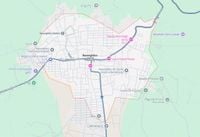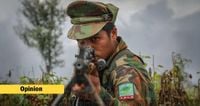After nearly a year of intense conflict, Myanmar's military has reclaimed the strategic town of Nawnghkio from rebel forces, marking a significant turnaround in the ongoing civil war that has gripped the country since the 2021 military coup. State media reported the recapture on July 17, 2025, highlighting the military’s rare success in the northeast region, where ethnic militias had seized large swaths of territory since late 2023.
Nawnghkio, located along a vital trade and military logistics corridor linking central Myanmar to China, had been under the control of the Ta’ang National Liberation Army (TNLA) since July 2024. The town’s strategic importance is underscored by its position on the Mandalay-Lashio highway and railway, as well as its proximity—about 40 kilometers—to Pyin Oo Lwin, home to Myanmar’s main military officer training academy.
The military’s operation to retake Nawnghkio was arduous and protracted, involving over 500 armed engagements, including 20 major clashes, over nearly 11 months. According to the state-run Myanma Alinn newspaper, 171 bodies of TNLA fighters and their allies were recovered, alongside captured ammunition supplies. The military also released images of soldiers celebrating their victory in front of government offices, hospitals, and markets within the town, signaling a symbolic restoration of state authority.
Despite the military’s claim, the TNLA did not acknowledge defeat outright. In a statement posted on the Telegram messaging app on July 16, 2025, the TNLA said it had relocated its civil administration and service offices to safer locations due to the intensity of the military’s offensive, making it difficult to continue operations in Nawnghkio. This move underscores the ongoing instability and the fluid nature of control in the region.
The recapture of Nawnghkio follows a similar military success just over a week earlier, when the army claimed to have retaken Mobye, another strategic town in southern Shan state, which had been held by an alliance of ethnic armed organizations since late 2023. Together, these victories mark a concerted effort by the military to regain control of key towns ahead of a general election planned for later this year—a poll widely seen as an attempt by the junta to legitimize its seizure of power.
Since the military coup in February 2021, Myanmar has been plunged into turmoil, with widespread protests evolving into a full-blown civil war. The conflict pits the military junta against a diverse coalition of ethnic militias and pro-democracy groups, including the Three Brotherhood Alliance—comprising the TNLA, the Myanmar National Democratic Alliance Army, and the Arakan Army—and the People’s Defense Force, a pro-democracy resistance group that emerged after the coup.
The offensive launched by the Three Brotherhood Alliance in late 2023 led to significant territorial gains in northeastern and western Myanmar, forcing the military onto the defensive in many areas. The capture of Nawnghkio by the TNLA was a major milestone in this campaign, as the town serves as a gateway to the Chinese border and a critical logistics route.
However, the TNLA’s hold on Nawnghkio was undermined by several strategic missteps. Independent analysts point to the group’s failure to neutralize nearby military installations fully, such as the No. 902 Artillery Operations Command south of the town, and key bases around Thabeikkyin, which the TNLA had also captured but did not consolidate effectively. These oversights left the military with footholds from which to launch counteroffensives.
Moreover, tensions within the ethnic armed groups themselves have weakened their cohesion. The TNLA has reportedly clashed with longtime allies like the Kachin Independence Army (KIA) and the Shan State Progress Party/Shan State Army-North (SSPP/SSA-N), even detaining KIA troops and dismantling their checkpoints. Armed clashes with the SSPP/SSA-N have resulted in casualties, reflecting a fracturing alliance that detracts from their collective resistance against the military.
Additionally, the TNLA's governance of captured territories has sparked local discontent. Accusations of monopolizing gemstone mining in Mogoke through partnerships with Chinese investors, displacing local communities, and suppressing Burman People’s Defense Force units have eroded support. Leaked videos allegedly showing the detention and abuse of Burman PDF fighters by TNLA troops have circulated on social media, further damaging the group’s reputation.
These internal conflicts and governance challenges have alienated local Shan, Kachin, and Burman communities, diminishing the TNLA’s operational effectiveness and legitimacy. A Lisu resident from Mogoke lamented, “We used to inform the TNLA about [junta] troop movements, but we are now deeply disappointed with the group and no longer wish to support them.”
The military’s recapture of Nawnghkio is also attributed to its growing use of advanced technologies, especially drones, and external pressure from China. While China maintains a delicate balance by engaging both the military government and ethnic armed groups, it fears that instability in Myanmar threatens its strategic investments and regional influence.
With Nawnghkio back under military control, the junta aims to consolidate its hold over the Mandalay-Lashio corridor—a crucial artery for trade and military logistics. Following the recapture of Lashio earlier this year through Chinese mediation, the military is poised to advance toward key towns like Kyaukme and Hsipaw, seeking to reestablish a continuous route to the northern border and tighten its grip on the region.
Meanwhile, the military is working to restore administrative functions in Nawnghkio, clear land mines, and facilitate the safe return of residents who fled during the fighting. The town’s recapture sends a clear message of the junta’s intent to regain control ahead of the upcoming election, even as resistance forces continue to challenge its authority.
Nay Phone Latt, spokesperson for the National Unity Government—the opposition coordinating resistance efforts—told The Associated Press that the military’s offensives are part of a broader strategy to reclaim resistance-held areas before the election, aiming to legitimize its power through the ballot box.
As the conflict grinds on, the fate of towns like Nawnghkio will likely remain contested, reflecting the complex interplay of military strategy, ethnic politics, and the struggle for Myanmar’s future.



